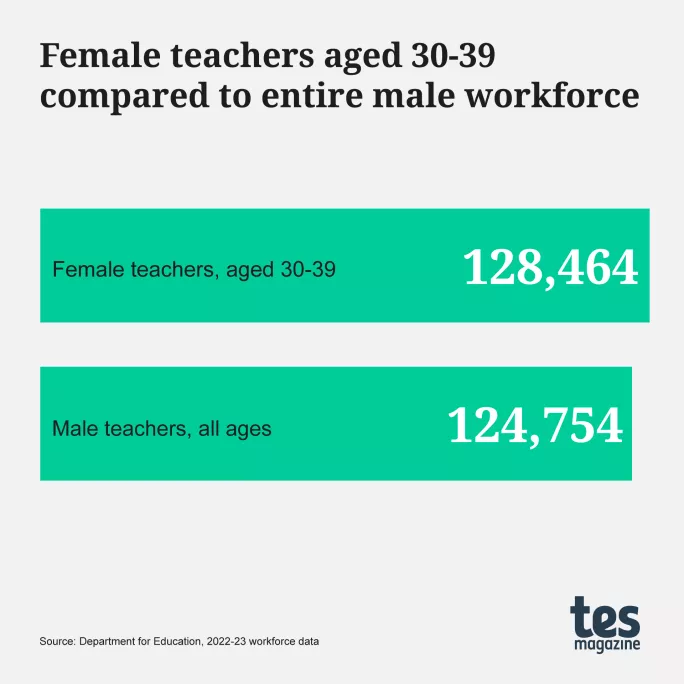
6 reasons why teaching can remain family friendly

Recent data from the Schools Workforce Census, combined with research from The Maternity Teacher Paternity Teacher Project (MTPT), has indicated that becoming a mother can spell disaster for women’s teaching careers.
But is the outlook as bleak as the data suggests, or is there a good news story within the data that reveals teaching can be family friendly?
Well, while women aged 30-39 - 55 per cent of whom are mothers - make up the largest group to leave teaching every year, they also make up a quarter of our total workforce. In fact, women aged 30-39 outnumber the entire population of male teachers by 3,710.

As such, while there are major obstacles presented by the motherhood penalty in education that need to be addressed to stop thousands leaving each year, there are thousands more remaining in the profession. So how are they making it work?
Research from the MTPT Project, which explored the experiences of more than 500 female teachers aged 30-39, gathering further detail through 42 follow-up interviews, revealed six reasons why teaching could, in fact, be the most family-friendly of career choices
Finances
Despite the general state of discontent around teacher pay, and a lamentable 18.1 per cent gender pay gap, finances were cited as the most popular retention measure for women aged 30-39, especially mothers, in order to pay mortgages, bills and childcare fees.
Furthermore, for teachers at certain stages of their careers, the idea of retraining and starting over in a new career would represent a significant salary reduction, which was just not feasible. What’s more, depending on participants’ regional location, teacher salaries were often more attractive than other options available to them as degree-educated employees.
Few interview participants, however, felt teaching was objectively a well-paid job, particularly when the long working hours were taken into account.
A love of teaching
Job satisfaction and a sense of professional commitment were the second and third most popular reasons for women still teaching aged 30-39. Given this, it’s not surprising, as long as pay and working conditions allow it, that so many female teachers remain in the profession even after becoming mothers.
Compatible childcare
A third of the study’s participants stated that compatible childcare logistics had enabled them to remain in the job they loved.
Examples of this included: childcare and school settings conveniently located close to home or teachers’ own schools; family support that provided flexibility in hours and reduced costs; or male partners who took on an equal or dominant share of the childcare responsibilities.
Flexible school cultures
There was a significant overlap here, however, between the compatibility of childcare logistics and the flexibility, compassion and often simply common sense offered by schools.
Whether this flexibility was defined by formalised part-time hours that offered mother-teachers a day’s saving on nursery fees (also cited in discussions around finances), or late starts and early finishes that eliminated the need for wraparound care, it was often very small adjustments on the part of the school that enabled women to remain teaching and leading.
This meant that teachers could work full-time and manage issues such as short-notice childcare emergencies, attending first days at school, managing school drop-offs and commutes across town and attending important meetings about their own children.
Progression opportunities
Finally, just over a quarter of participants said career progression was a reason for remaining in teaching.
Education - particularly according to career changers - was perceived as an industry that offered growth and new challenges in both a linear fashion, and by broadening and enriching knowledge horizontally.
The mother-teachers who spoke about career progression in the follow-up interviews fell into two categories: either they were ambitious in the pursuit of senior leadership positions, and roles that allowed them to have a positive impact; or they were motivated by developing their subject or pedagogical knowledge to hone classroom practice.
Although instances of sex-based and pregnancy and maternity discrimination were still present in the narratives of those who had stayed in teaching, these women spoke far more about the way school leaders had reduced or removed barriers to their progression.
This included ensuring teachers on maternity leave were informed of vacancies or CPD opportunities and invited to take part.
Time to act
It’s evident that there are schools offering great working conditions for parent-teachers that help thousands of women aged 30-39 remain in the profession.
If, though, as a teacher in this bracket, or indeed any other, it feels as if teaching isn’t compatible with family life, it is worth searching for a setting that will meet your needs, as it probably exists.
For leaders, this should serve as a timely reminder that if your school or MAT culture does not support working parents, you need to make the (often small) changes required to become a more family-friendly setting - or risk losing talented staff to more progressive organisations.
Emma Sheppard is a lead practitioner for English and the founder of the Maternity Teacher Paternity Teacher (MTPT) Project
You need a Tes subscription to read this article
Subscribe now to read this article and get other subscriber-only content:
- Unlimited access to all Tes magazine content
- Exclusive subscriber-only stories
- Award-winning email newsletters
- Unlimited access to all Tes magazine content
- Exclusive subscriber-only stories
- Award-winning email newsletters
You need a subscription to read this article
Subscribe now to read this article and get other subscriber-only content, including:
- Unlimited access to all Tes magazine content
- Exclusive subscriber-only stories
- Award-winning email newsletters
- Unlimited access to all Tes magazine content
- Exclusive subscriber-only stories
- Award-winning email newsletters
topics in this article



